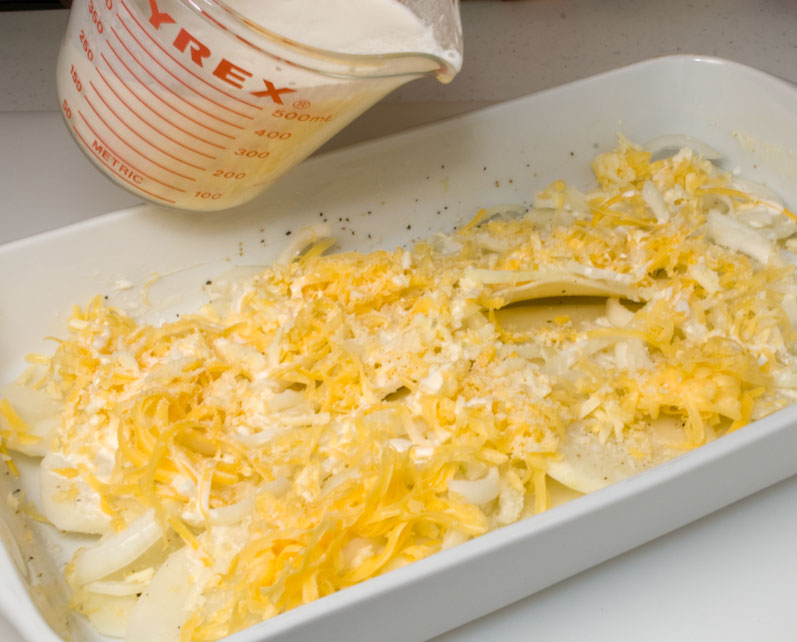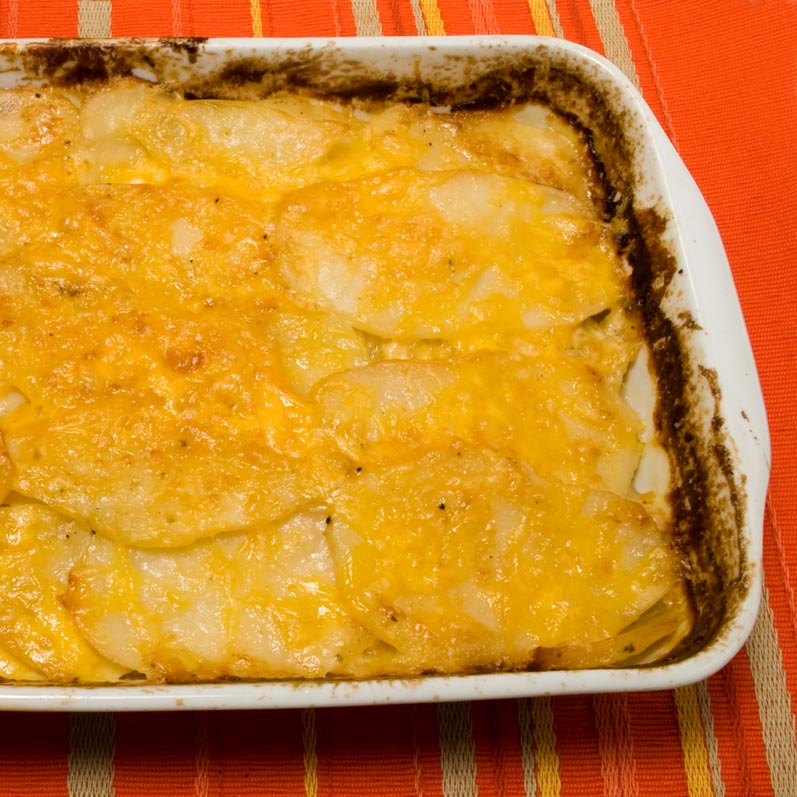Is there anything finer in the world of vegetable cookery than a properly made Potato Gratin? Not in my book.

Actually, there are three basic types: one is made with heavy cream (Gratin Jurassien), one with half-and-half or milk (Gratin Dauphinois), and one with chicken or beef stock (Gratin Savoyard).

Although the methodology for all three is basically simple, there is a complicating factor that needs consideration. Potatoes are surprisingly acidic and have a definite tendency to curdle milk, half-and-half, and even, but to a lesser degree, heavy cream. (Check out the lively forum discussion on ChowHound titled, Argh, I Hate You Potatoes Au Gratin, if you think this is a slam-dunk dish.)
To minimize this possibility, potato slices can be neutralized with a preliminary blanching of 10 minutes in simmering milk. Because the potatoes are then partially cooked, the liquid requirement for the gratin decreases by about one-third.

Another way to control this undesirable side-effect is to regulate the oven heat so that the gratin is never actually boiling, while also monitoring the length of time the dish is in the oven, so that overcooking does not occur (which does in itself have a negative textural effect on milk or half-and-half).
Yet another trick is to use 1 tablespoon flour per cup of liquid, which also discourages curdling.
Now my own preference is to use ½ heavy cream (which is more stable than either half and half or milk), ½ chicken stock, and a small amount of flour for a gratin that is both wonderfully creamy and flavorful, but without the heavy calories of an all-cream gratin.
One More Thing
On another front, the cheese you use in a gratin will itself curdle (separate and become gummy and chewy) if it is overheated. With young cheeses, curdling is virtually guaranteed. Aged cheeses, however, give you much wider latitude. I always bake with cheeses that are aged for at least a year. This is typically specified on the wrapper.

Basic Potato Gratin with Seven Variations
The liquid measurement here is divided between cream and chicken stock, which is my favorite combination. However, as mentioned above, all cream, all milk, or all half-and-half can be used instead.
1 tablespoon unsalted butter
1½ tablespoons unbleached, all-purpose flour
¾ cup chicken stock
¾ cup heavy cream
3 plump cloves garlic, finely minced, optional
2½ pounds baking potatoes,* peeled, sliced 1/4-inch thick, and covered with cold water
fine sea salt
freshly ground white or black pepper
2 cups grated Gruyere, Emmenthaler, cheddar, or other well-aged, melting cheese of choice (4 ounces)
3 tablespoons finely grated parmesan
- Butter 9- by 12-inch, 12-cup capacity, baking dish.
- In a small mixing bowl, whisk together the flour and a couple tablespoons of the chicken stock until smooth.
- Add the rest of the chicken stock, cream, and garlic and whisk to combine. Reserve.
- Carefully dry the potato slices with a clean kitchen towel and begin layering them into the dish.
- Season each layer rather heavily with salt, pepper, a portion of the grated cheese, 1 tablespoon parmesan, and a portion of the cream mixture.
-
Proceed with layering, ending with a top layer of potatoes, final drizzle of cream mixture, and a final topping of cheeses. (I typically have three layers of potatoes.)
NOTE The amount of liquid a given batch of potatoes at a given point in time will absorb is always variable. The liquid should reach a little more than halfway up to the top of the potato layers. Check the gratin periodically and add more liquid if needed. Remember though, you want only a light binding of sauce present when the potatoes are fully tender; too much liquid makes the gratin soupy.
-
Bake in the upper third of the oven at 375º for 45-60 minutes, covering the baking dish with DOMED foil tent for the first 30 minutes of baking time. When done potatoes will be tender and top will be nicely browned.
NOTE If you opted to blanch the potatoes in milk as indicated in the opening paragraph, the cooking time will be around 30 minutes.
- This dish can wait, loosely covered, for half an hour or so. To hold it any longer, stop the cooking process just before the last bit of liquid has been absorbed, cool, cover and refrigerate, and then reheat gently, covered with foil, in a 325º oven for about 30 minutes before serving.
Serves 4-6.
*By baking potatoes, I mean the brown-skinned Russet Burbank potato. They cook to a lovely homogeneous mass with some separation remaining between slices. If you prefer the potato slices to retain more separateness in the gratin, use boiling potatoes, such as Red Pontiac “new” potatoes or White Rose potatoes. They will be a little sweeter tasting than Russet Burbanks.
Potato Gratin Variations
Potato & Onion or Leek Gratin (My Favorite)
Peel and thinly slice 1 medium-sized onion or 2 sliced leeks (white and pale green parts only) and layer it with potatoes. The natural sweetness of the onion will be enhanced with the addition of cinnamon, nutmeg, and cloves–just a tiny pinch of each added to the liquid ingredient.
Potato & Wild Mushroom Gratin
Sauté ½ pound boletus, chanterelle, morel, or other edible wild mushrooms, sliced, in 1 tablespoon unsalted butter until they release their juices. Add the juices to a combination of heavy cream and chicken stock to measure 1½ cups. Layer the mushrooms with potatoes. Finely minced fresh or dried rosemary is very nice with this combination.
Potato Gratin with Fresh Herbs
Up to 2 tablespoons fresh herbs–parsley, tarragon, rosemary, oregano, thyme, or chives–can be used singly or in combination with one another for this gratin. Layer them, finely minced, with the potatoes.
Potato & Carrot or Yam Gratin
Alternate sliced potatoes with sliced carrots or yams, seasoning with a bit of dill weed, and proceed as in the master recipe.
Smoked Salmon & Potato Gratin
A light custard sauce is the difference here.
Layer ¼-½ pound cold-smoked salmon, chopped, with parboiled potatoes. Add an egg to 1½ cups half-and-half, mix well, and pour over the gratin. Regulate the heat so that the gratin never reaches a simmer.
Potato Gratin with Ham, Sausage, or Bacon
Layer ¼-½ pound fully cooked, sliced or diced ham, sausage, or bacon with the potatoes. Aged cheddar works particularly well with these meats.
Potato, Onion, Apple, & Sausage Gratin
This gratin takes the concept to its limit, creating a complete meal in the process.
Layer with the potatoes with 1 medium-sized onion, peeled and sliced; 2 tart green apples, peeled, cored, and sliced; and ¼-½ pounds fully cooked bulk breakfast or Italian-style sausage. For the liquid, use ½ chicken stock and ½ cream, increasing the total amount to 1¾ cups. A pinch of fresh or dried thyme is perfect here.
More Potato Gratins from LunaCafe
Cookin’ with Gas (inspiration from around the web)
- A Cozy Kitchen: Sweet Potato Gratin with Chanterelles and Comté
- Alexandra’s Kitchen: Alice Waters’ Potato Gratin
- Brown Eyed Baker: Bacon and Mushroom Potato Gratin
- Closet Cooking: Pancetta and Porcini Potato Gratin
- Leite’s Culinaria: Old-Fashioned Potato Gratin
Happy Cooking!
Copyright 2013-2021 Susan S. Bradley. All rights reserved.

Thanks, Kevin! Let me know when you have that side-by-side comparison ready, OK? You’ll need a taste tester and I can run right over.
Nicely done and great explanation. Always learn something new and cool when I read your posts.
Jeff´s last blog post..Meyer Lemon Cookies
Thanks Jeff! This is great to hear.
The problem that I used to have with potato gratin was not that it curdled, but that I would never know the right amount of liquid to add to my potatoes. Recipes are good and all, but if I wanted to fill a smaller or larger gratin dish that’d go out the window.
In an act of extreme geekiness I scanned a number of recipes and found that a potato/cream ratio of 0.4 is ideal. Works every time
Tim´s last blog post..Do you struggle with the pain of defrosting?
LOL. I love geekiness in the kitchen. Much better to put in a little time with research and/or testing than to make a mediocre dish again and again, eh?
I love geekiness in the kitchen. Much better to put in a little time with research and/or testing than to make a mediocre dish again and again, eh?